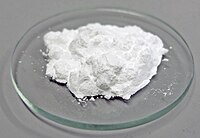
Photo from wikipedia
Renewable energy sources have received much attention in recent years due to concerns about global climate and environmental changes. Solar energy appears to be a promising alternative, especially dye-sensitized solar… Click to show full abstract
Renewable energy sources have received much attention in recent years due to concerns about global climate and environmental changes. Solar energy appears to be a promising alternative, especially dye-sensitized solar cells (DSSC), which, according to the literature, can achieve a power conversion efficiency in excess of 11%, depending on the semiconductor oxide used in their fabrication. The aim of this paper is to investigate the performance of DSSCs using cerium oxide (CeO2), titanium oxide (TiO2), and commercial dye N719. CeO2 was obtained using the Pechini and precipitation methods. The characterization techniques employed were x-ray diffraction, Raman spectroscopy, scanning electron microscopy, ultraviolet–visible spectroscopy, dynamic light scattering, and photoelectrochemical measurements. The results indicate that the efficiency of the DSSC CeO2/TiO2 obtained using the precipitation method was about 20% higher than that of the DSSC TiO2.
Journal Title: Journal of Electronic Materials
Year Published: 2018
Link to full text (if available)
Share on Social Media: Sign Up to like & get
recommendations!